Circular RNA Expression Profiling by Microarray—A Technical and Practical Perspective
Abstract
1. Introduction
2. CircRNA Expression Profiling by Microarray
3. CircRNA Microarray Analysis and Annotation
- Database source
- Chromosomal coordinates
- Host gene
- Best transcript
- CircRNA type (Figure 1)
- CircRNA length
- Probe sequence
- Top five miRNA binding sites
4. circRNA Biomarkers in Biofluids and Exosomes
5. Confirmation of Differentially Expressed circRNAs
- The forward and reverse circRNA-qPCR primers should be situated separately on the two sides of the circular junction, such that the amplicon spans the circular junction (Figure 6). The primer sequence and amplicon design can follow the same guidelines for linear RNA qPCR using a software tool (e.g., Primer3Plus).
- Circular RNAs do not have a poly(A) tail. Random RT primers, instead of oligo(dT), are used in the first-strand cDNA synthesis.
- An amount of 0.5–2 µg of total RNA is used as the starting material. RNase R treatment for circRNA enrichment is not necessary and not performed. The synthesized cDNA can be used for both circRNA and linear mRNA qPCR.
- Linear housekeeping genes, such as GAPDH, ACTB, B2M, or 18S rRNA, can continue to be used normally as the qPCR normalization reference. For biofluid samples, the average of more than one housekeeping gene or the input biofluid volumes can also be used for the normalization reference. Currently, no known circRNAs have been qualified as “housekeeping” circRNAs that are stably expressed at high levels across all tissues and cell types.
- Post-qPCR melt curve analysis should be used to ensure the specific amplification and the absence of primer dimers.
- Optional: The qPCR product can be run on a gel to verify if the DNA is a specific single band and if its size is in agreement with the predicted amplicon size.
- Optional: The qPCR product can be cleaned up and Sanger-sequenced for circular junction sequence confirmation.
- Optional: Circular:linear ratios can be compared in parallel qPCRs with and without RNase R treatment, using primers that are specific for circular RNA sites only and for linear RNA sites only. An increase in the circular:linear ratio by RNase R treatment is a strong indication of the RNA being circRNA.
- Caveats: Template switching during the reverse-transcription step of cDNA synthesis can occur, which can produce spuriously joined exons as “circRNAs” and false-positive signals [36].
6. Highlights of circRNAs Identified on circRNA Microarrays
7. CircRNA Microarray Advantages Compared with Sequencing
Funding
Conflicts of Interest
References
- Salzman, J.; Gawad, C.; Wang, P.L.; Lacayo, N.; Brown, P.O. Circular RNAs are the predominant transcript isoform from hundreds of human genes in diverse cell types. PLOS ONE 2012, 7, e30733. [Google Scholar] [CrossRef] [PubMed]
- Salzman, J.; Chen, R.E.; Olsen, M.N.; Wang, P.L.; Brown, P.O. Cell-type specific features of circular RNA expression. PLoS Genet. 2013, 9, e1003777. [Google Scholar] [CrossRef]
- Memczak, S.; Jens, M.; Elefsinioti, A.; Torti, F.; Krueger, J.; Rybak, A.; Maier, L.; Mackowiak, S.D.; Gregersen, L.H.; Munschauer, M.; et al. Circular RNAs are a large class of animal RNAs with regulatory potency. Nature 2013, 495, 333–338. [Google Scholar] [CrossRef] [PubMed]
- Jeck, W.R.; Sorrentino, J.A.; Wang, K.; Slevin, M.K.; Burd, C.E.; Liu, J.; Marzluff, W.F.; Sharpless, N.E. Circular RNAs are abundant, conserved, and associated with ALU repeats. RNA 2013, 19, 141–157. [Google Scholar] [CrossRef]
- Guo, J.U.; Agarwal, V.; Guo, H.; Bartel, D.P. Expanded identification and characterization of mammalian circular RNAs. Genome Biol. 2014, 15, 409. [Google Scholar] [CrossRef] [PubMed]
- Zhang, X.O.; Wang, H.B.; Zhang, Y.; Lu, X.; Chen, L.L.; Yang, L. Complementary sequence-mediated exon circularization. Cell 2014, 159, 134–147. [Google Scholar] [CrossRef] [PubMed]
- Zhang, Y.; Zhang, X.O.; Chen, T.; Xiang, J.F.; Yin, Q.F.; Xing, Y.H.; Zhu, S.; Yang, L.; Chen, L.L. Circular intronic long noncoding RNAs. Mol. Cell 2013, 51, 792–806. [Google Scholar] [CrossRef]
- You, X.; Vlatkovic, I.; Babic, A.; Will, T.; Epstein, I.; Tushev, G.; Akbalik, G.; Wang, M.; Glock, C.; Quedenau, C.; et al. Neural circular RNAs are derived from synaptic genes and regulated by development and plasticity. Nat. Neurosci. 2015, 18, 603–610. [Google Scholar] [CrossRef]
- Capel, B.; Swain, A.; Nicolis, S.; Hacker, A.; Walter, M.; Koopman, P.; Goodfellow, P.; Lovell-Badge, R. Circular transcripts of the testis-determining gene Sry in adult mouse testis. Cell 1993, 73, 1019–1030. [Google Scholar] [CrossRef]
- Rophina, M.; Sharma, D.; Poojary, M.; Scaria, V. Circad: A comprehensive manually curated resource of circular RNA associated with diseases. Database 2020, 2020, baaa019. [Google Scholar] [CrossRef]
- Yang, Y.; Fan, X.; Mao, M.; Song, X.; Wu, P.; Zhang, Y.; Jin, Y.; Yang, Y.; Chen, L.L.; Wang, Y.; et al. Extensive translation of circular RNAs driven by N(6)-methyladenosine. Cell Res. 2017, 27, 626–641. [Google Scholar] [CrossRef] [PubMed]
- Legnini, I.; Di Timoteo, G.; Rossi, F.; Morlando, M.; Briganti, F.; Sthandier, O.; Fatica, A.; Santini, T.; Andronache, A.; Wade, M.; et al. Circ-ZNF609 Is a circular RNA that can be translated and functions in myogenesis. Mol. Cell 2017, 66, 22–37 e29. [Google Scholar] [CrossRef] [PubMed]
- Miao, Q.; Ni, B.; Tang, J. Coding potential of circRNAs: New discoveries and challenges. PeerJ 2021, 9, e10718. [Google Scholar] [CrossRef] [PubMed]
- Hansen, T.B.; Jensen, T.I.; Clausen, B.H.; Bramsen, J.B.; Finsen, B.; Damgaard, C.K.; Kjems, J. Natural RNA circles function as efficient microRNA sponges. Nature 2013, 495, 384–388. [Google Scholar] [CrossRef]
- Thomas, L.F.; Saetrom, P. Circular RNAs are depleted of polymorphisms at microRNA binding sites. Bioinformatics 2014, 30, 2243–2246. [Google Scholar] [CrossRef]
- Dudekula, D.B.; Panda, A.C.; Grammatikakis, I.; De, S.; Abdelmohsen, K.; Gorospe, M. CircInteractome: A web tool for exploring circular RNAs and their interacting proteins and microRNAs. RNA Biol. 2016, 13, 34–42. [Google Scholar] [CrossRef]
- Panda, A.C.; Dudekula, D.B.; Abdelmohsen, K.; Gorospe, M. Analysis of circular RNAs using the web tool circinteractome. Methods Mol. Biol. 2018, 1724, 43–56. [Google Scholar]
- Zeng, Y.; Du, W.W.; Wu, Y.; Yang, Z.; Awan, F.M.; Li, X.; Yang, W.; Zhang, C.; Yang, Q.; Yee, A.; et al. A circular RNA binds to and activates akt phosphorylation and nuclear localization reducing apoptosis and enhancing cardiac repair. Theranostics 2017, 7, 3842–3855. [Google Scholar] [CrossRef]
- Xia, P.; Wang, S.; Ye, B.; Du, Y.; Li, C.; Xiong, Z.; Qu, Y.; Fan, Z. A circular RNA protects dormant hematopoietic stem cells from DNA Sensor cGAS-mediated exhaustion. Immunity 2018, 48, 688–701 e687. [Google Scholar] [CrossRef]
- Zhang, Y.; Huang, G.; Yuan, Z.; Zhang, Y.; Chen, X.; Huang, J.; Li, N.; Liu, Z.; Zhong, W.; Huang, H.; et al. Profiling and bioinformatics analysis revealing differential circular rna expression about storage lesion regulatory in stored red blood cells. Transfus. Med. Hemother. 2022, 49, 76–87. [Google Scholar] [CrossRef]
- Van Gelder, R.N.; von Zastrow, M.E.; Yool, A.; Dement, W.C.; Barchas, J.D.; Eberwine, J.H. Amplified RNA synthesized from limited quantities of heterogeneous cDNA. Proc. Natl. Acad. Sci. USA 1990, 87, 1663–1667. [Google Scholar] [CrossRef] [PubMed]
- Li, J.; Eberwine, J. The successes and future prospects of the linear antisense RNA amplification methodology. Nat. Protoc. 2018, 13, 811–818. [Google Scholar] [CrossRef] [PubMed]
- Bolstad, B.M.; Irizarry, R.A.; Astrand, M.; Speed, T.P. A comparison of normalization methods for high density oligonucleotide array data based on variance and bias. Bioinformatics 2003, 19, 185–193. [Google Scholar] [CrossRef] [PubMed]
- Ritchie, M.E.; Phipson, B.; Wu, D.; Hu, Y.; Law, C.W.; Shi, W.; Smyth, G.K. limma powers differential expression analyses for RNA-sequencing and microarray studies. Nucleic. Acids. Res. 2015, 43, e47. [Google Scholar] [CrossRef]
- Salmena, L.; Poliseno, L.; Tay, Y.; Kats, L.; Pandolfi, P.P. A ceRNA hypothesis: The Rosetta Stone of a hidden RNA language? Cell 2011, 146, 353–358. [Google Scholar] [CrossRef]
- Tay, Y.; Kats, L.; Salmena, L.; Weiss, D.; Tan, S.M.; Ala, U.; Karreth, F.; Poliseno, L.; Provero, P.; Di Cunto, F.; et al. Coding-independent regulation of the tumor suppressor PTEN by competing endogenous mRNAs. Cell 2011, 147, 344–357. [Google Scholar] [CrossRef]
- Tay, Y.; Rinn, J.; Pandolfi, P.P. The multilayered complexity of ceRNA crosstalk and competition. Nature 2014, 505, 344–352. [Google Scholar] [CrossRef]
- Alexa, A.; Rahnenfuhrer, J.; Lengauer, T. Improved scoring of functional groups from gene expression data by decorrelating GO graph structure. Bioinformatics 2006, 22, 1600–1607. [Google Scholar] [CrossRef]
- Huang, W.; Sherman, B.T.; Lempicki, R.A. Systematic and integrative analysis of large gene lists using DAVID bioinformatics resources. Nat. Protoc. 2009, 4, 44–57. [Google Scholar] [CrossRef]
- Sherman, B.T.; Hao, M.; Qiu, J.; Jiao, X.; Baseler, M.W.; Lane, H.C.; Imamichi, T.; Chang, W. DAVID: A web server for functional enrichment analysis and functional annotation of gene lists (2021 update). Nucleic. Acids Res. 2022, 50, W216–W221. [Google Scholar] [CrossRef]
- Enright, A.J.; John, B.; Gaul, U.; Tuschl, T.; Sander, C.; Marks, D.S. MicroRNA targets in Drosophila. Genome Biol. 2003, 5, R1. [Google Scholar] [CrossRef] [PubMed]
- Agarwal, V.; Bell, G.W.; Nam, J.W.; Bartel, D.P. Predicting effective microRNA target sites in mammalian mRNAs. Elife 2015, 4, e05005. [Google Scholar] [CrossRef] [PubMed]
- McGeary, S.E.; Lin, K.S.; Shi, C.Y.; Pham, T.M.; Bisaria, N.; Kelley, G.M.; Bartel, D.P. The biochemical basis of microRNA targeting efficacy. Science 2019, 366, eaav1741. [Google Scholar] [CrossRef] [PubMed]
- Wen, G.; Zhou, T.; Gu, W. The potential of using blood circular RNA as liquid biopsy biomarker for human diseases. Protein Cell 2021, 12, 911–946. [Google Scholar] [CrossRef] [PubMed]
- Li, Y.; Zeng, X.; He, J.; Gui, Y.; Zhao, S.; Chen, H.; Sun, Q.; Jia, N.; Yuan, H. Circular RNA as a biomarker for cancer: A systematic meta-analysis. Oncol. Lett. 2018, 16, 4078–4084. [Google Scholar] [CrossRef] [PubMed]
- Szabo, L.; Salzman, J. Detecting circular RNAs: Bioinformatic and experimental challenges. Nat. Rev. Genet. 2016, 17, 679–692. [Google Scholar] [CrossRef]
- Garikipati, V.N.S.; Verma, S.K.; Cheng, Z.; Liang, D.; Truongcao, M.M.; Cimini, M.; Yue, Y.; Huang, G.; Wang, C.; Benedict, C.; et al. Circular RNA CircFndc3b modulates cardiac repair after myocardial infarction via FUS/VEGF-A axis. Nat. Commun. 2019, 10, 4317. [Google Scholar] [CrossRef]
- Chen, Q.; Wang, H.; Li, Z.; Li, F.; Liang, L.; Zou, Y.; Shen, H.; Li, J.; Xia, Y.; Cheng, Z.; et al. Circular RNA ACTN4 promotes intrahepatic cholangiocarcinoma progression by recruiting YBX1 to initiate FZD7 transcription. J. Hepatol. 2022, 76, 135–147. [Google Scholar] [CrossRef]
- Wang, X.; Xing, L.; Yang, R.; Chen, H.; Wang, M.; Jiang, R.; Zhang, L.; Chen, J. The circACTN4 interacts with FUBP1 to promote tumorigenesis and progression of breast cancer by regulating the expression of proto-oncogene MYC. Mol. Cancer 2021, 20, 91. [Google Scholar] [CrossRef]
- Gu, Y.; Wang, Y.; He, L.; Zhang, J.; Zhu, X.; Liu, N.; Wang, J.; Lu, T.; He, L.; Tian, Y.; et al. Circular RNA circIPO11 drives self-renewal of liver cancer initiating cells via Hedgehog signaling. Mol. Cancer 2021, 20, 132. [Google Scholar] [CrossRef]
- Yang, L.; Han, B.; Zhang, Z.; Wang, S.; Bai, Y.; Zhang, Y.; Tang, Y.; Du, L.; Xu, L.; Wu, F.; et al. Extracellular Vesicle-Mediated Delivery of Circular RNA SCMH1 Promotes Functional Recovery in Rodent and Nonhuman Primate Ischemic Stroke Models. Circulation 2020, 142, 556. [Google Scholar] [CrossRef] [PubMed]
- Panda, A.C.; De, S.; Grammatikakis, I.; Munk, R.; Yang, X.; Piao, Y.; Dudekula, D.B.; Abdelmohsen, K.; Gorospe, M. High-purity circular RNA isolation method (RPAD) reveals vast collection of intronic circRNAs. Nucleic Acids Res. 2017, 45, e116. [Google Scholar] [CrossRef] [PubMed]
- Pandey, P.R.; Rout, P.K.; Das, A.; Gorospe, M.; Panda, A.C. RPAD (RNase R treatment, polyadenylation, and poly(A)+ RNA depletion) method to isolate highly pure circular RNA. Methods 2018, 155, 41–48. [Google Scholar] [CrossRef] [PubMed]
- Zhang, X.-O.; Dong, R.; Zhang, Y.; Zhang, J.-L.; Luo, Z.; Zhang, J.; Chen, L.-L.; Yang, L. Diverse alternative back-splicing and alternative splicing landscape of circular RNAs. Genome Res. 2016, 26, 1277–1287. [Google Scholar] [CrossRef] [PubMed]
- Westholm, J.O.; Miura, P.; Olson, S.; Shenker, S.; Joseph, B.; Sanfilippo, P.; Celniker, S.E.; Graveley, B.R.; Lai, E.C. Genome-wide analysis of drosophila circular RNAs reveals their structural and sequence properties and age-dependent neural accumulation. Cell Rep. 2014, 9, 1966–1980. [Google Scholar] [CrossRef] [PubMed]
- Gao, Y.; Wang, J.; Zhao, F. CIRI: An efficient and unbiased algorithm for de novo circular RNA identification. Genome Biol. 2015, 16, 4. [Google Scholar] [CrossRef]
- Wang, K.; Singh, D.; Zeng, Z.; Coleman, S.J.; Huang, Y.; Savich, G.L.; He, X.; Mieczkowski, P.; Grimm, S.A.; Perou, C.M.; et al. MapSplice: Accurate mapping of RNA-seq reads for splice junction discovery. Nucleic. Acids Res. 2010, 38, e178. [Google Scholar] [CrossRef]
- Hansen, T.B. Improved circRNA identification by combining prediction algorithms. Front. Cell Dev. Biol. 2018, 6, 20. [Google Scholar] [CrossRef]
- Rabin, A.; Zaffagni, M.; Ashwal-Fluss, R.; Patop, I.L.; Jajoo, A.; Shenzis, S.; Carmel, L.; Kadener, S. SRCP: A comprehensive pipeline for accurate annotation and quantification of circRNAs. Genome Biol. 2021, 22, 277. [Google Scholar] [CrossRef]
- Hardwick, S.A.; Chen, W.Y.; Wong, T.; Deveson, I.W.; Blackburn, J.; Andersen, S.B.; Nielsen, L.K.; Mattick, J.S.; Mercer, T.R. Spliced synthetic genes as internal controls in RNA sequencing experiments. Nat. Methods 2016, 13, 792–798. [Google Scholar] [CrossRef]
- Chen, I.; Chen, C.Y.; Chuang, T.J. Biogenesis, identification, and function of exonic circular RNAs. Wiley Interdiscip. Rev. RNA 2015, 6, 563–579. [Google Scholar] [CrossRef] [PubMed]
- Xu, W.; Seok, J.; Mindrinos, M.N.; Schweitzer, A.C.; Jiang, H.; Wilhelmy, J.; Clark, T.A.; Kapur, K.; Xing, Y.; Faham, M.; et al. Inflammation and Host Response to Injury Large-Scale Collaborative Research, P. Human transcriptome array for high-throughput clinical studies. Proc. Natl. Acad. Sci. USA 2011, 108, 3707–3712. [Google Scholar] [CrossRef] [PubMed]
- Robinson, M.D.; McCarthy, D.J.; Smyth, G.K. edgeR: A Bioconductor package for differential expression analysis of digital gene expression data. Bioinformatics 2010, 26, 139–140. [Google Scholar] [CrossRef] [PubMed]
- McCarthy, D.J.; Chen, Y.; Smyth, G.K. Differential expression analysis of multifactor RNA-Seq experiments with respect to biological variation. Nucleic. Acids Res. 2012, 40, 4288–4297. [Google Scholar] [CrossRef]
- Chen, Y.; Lun, A.T.; Smyth, G.K. From reads to genes to pathways: Differential expression analysis of RNA-Seq experiments using Rsubread and the edgeR quasi-likelihood pipeline. F1000Research 2016, 5, 1438. [Google Scholar]


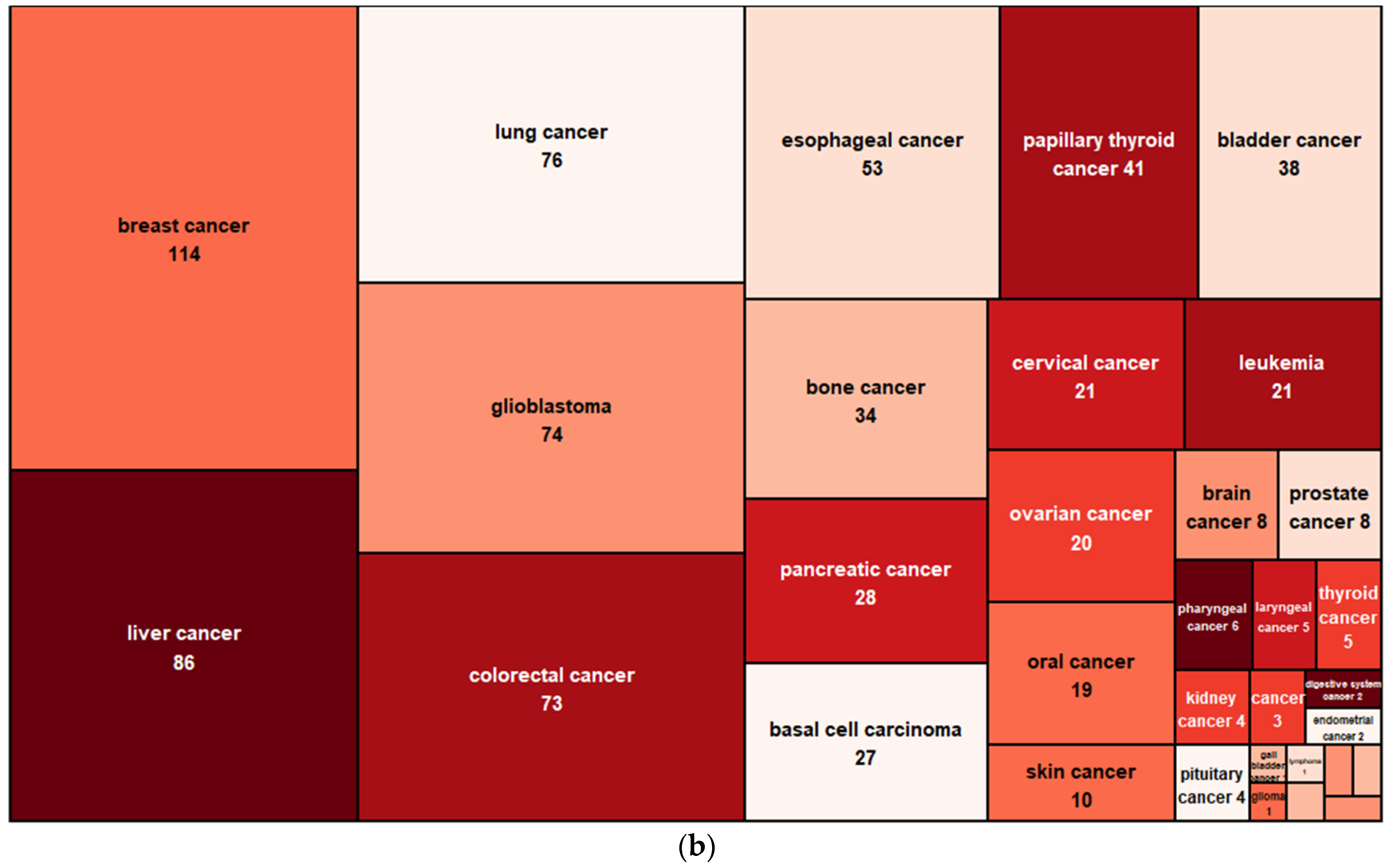
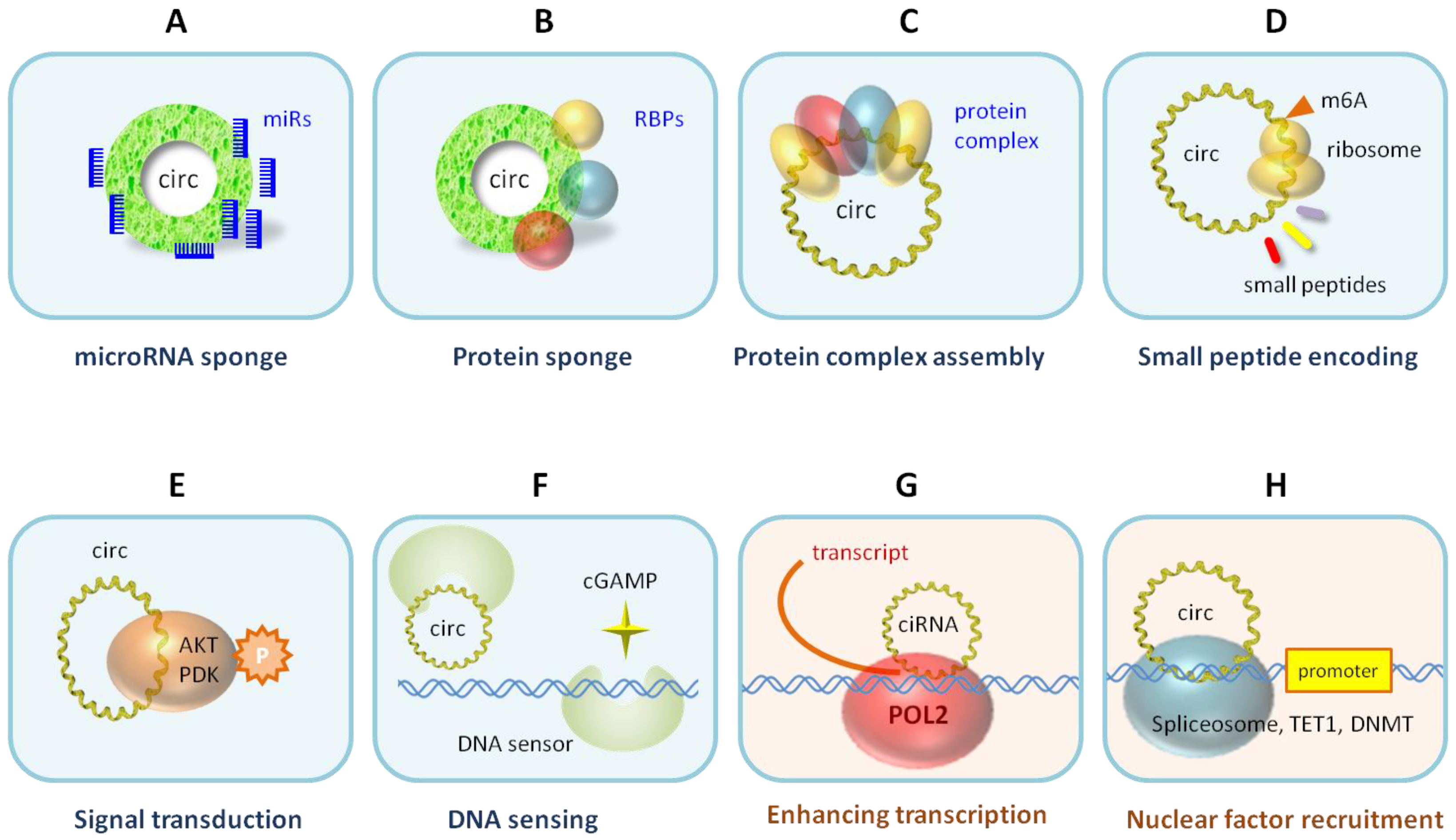
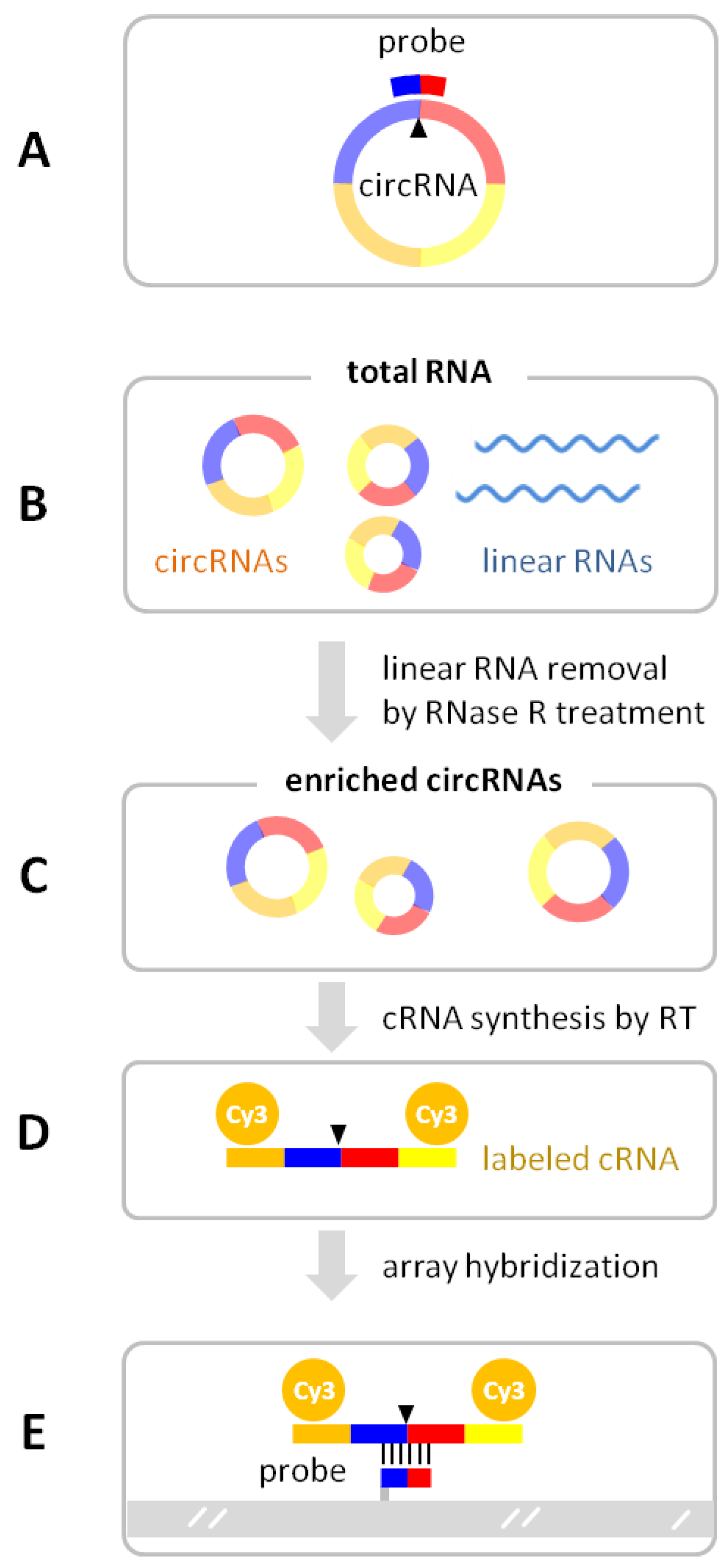

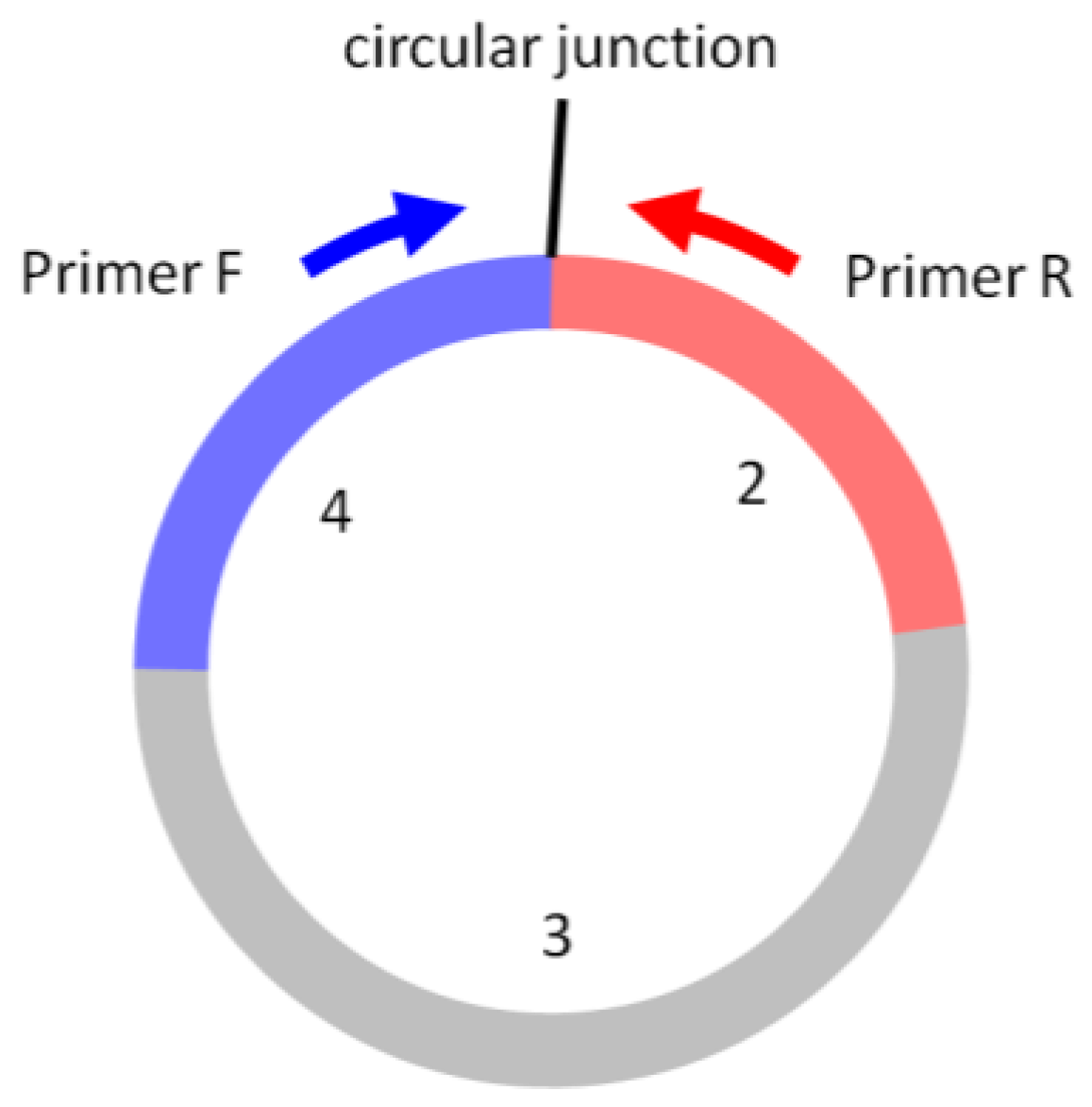
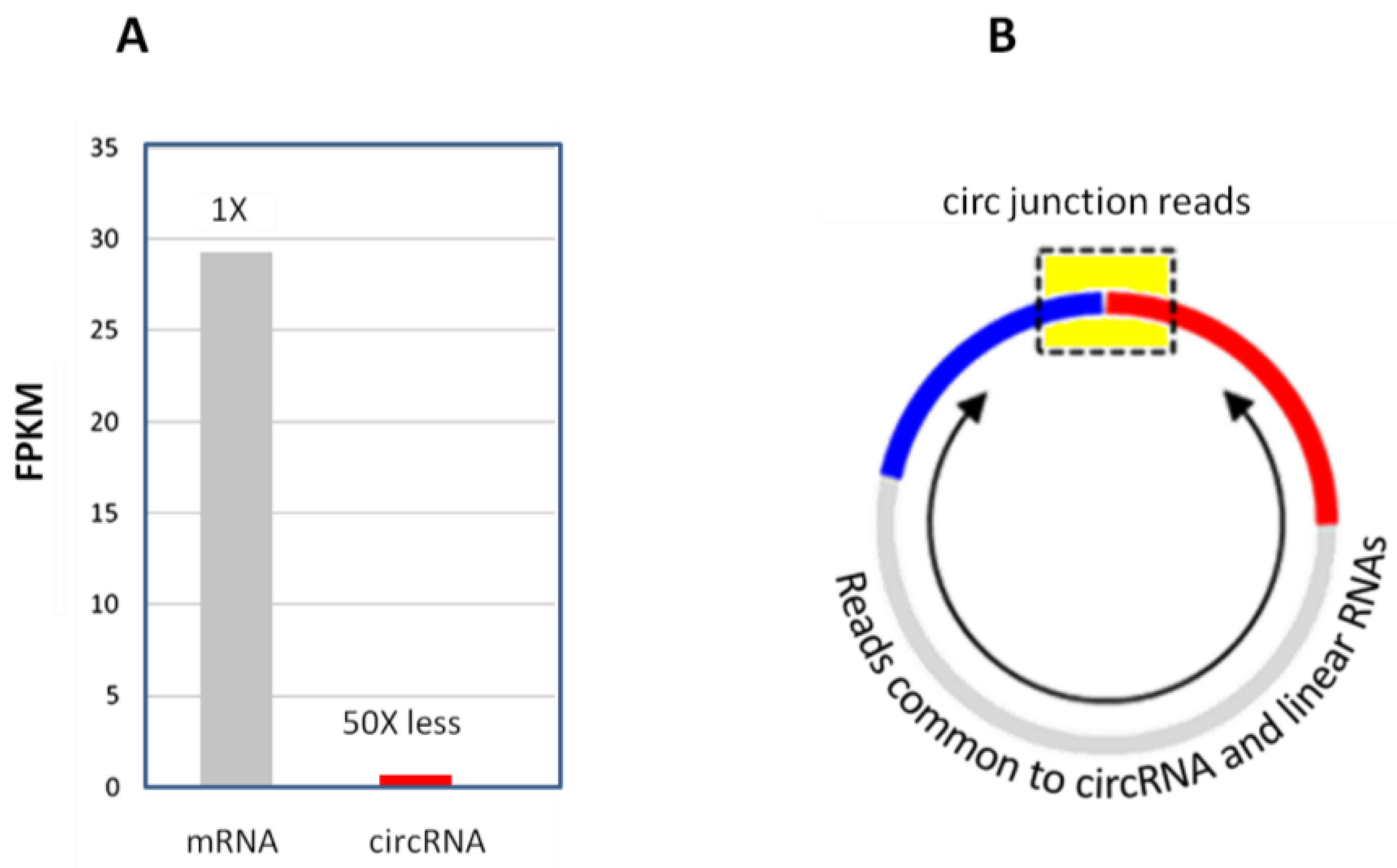
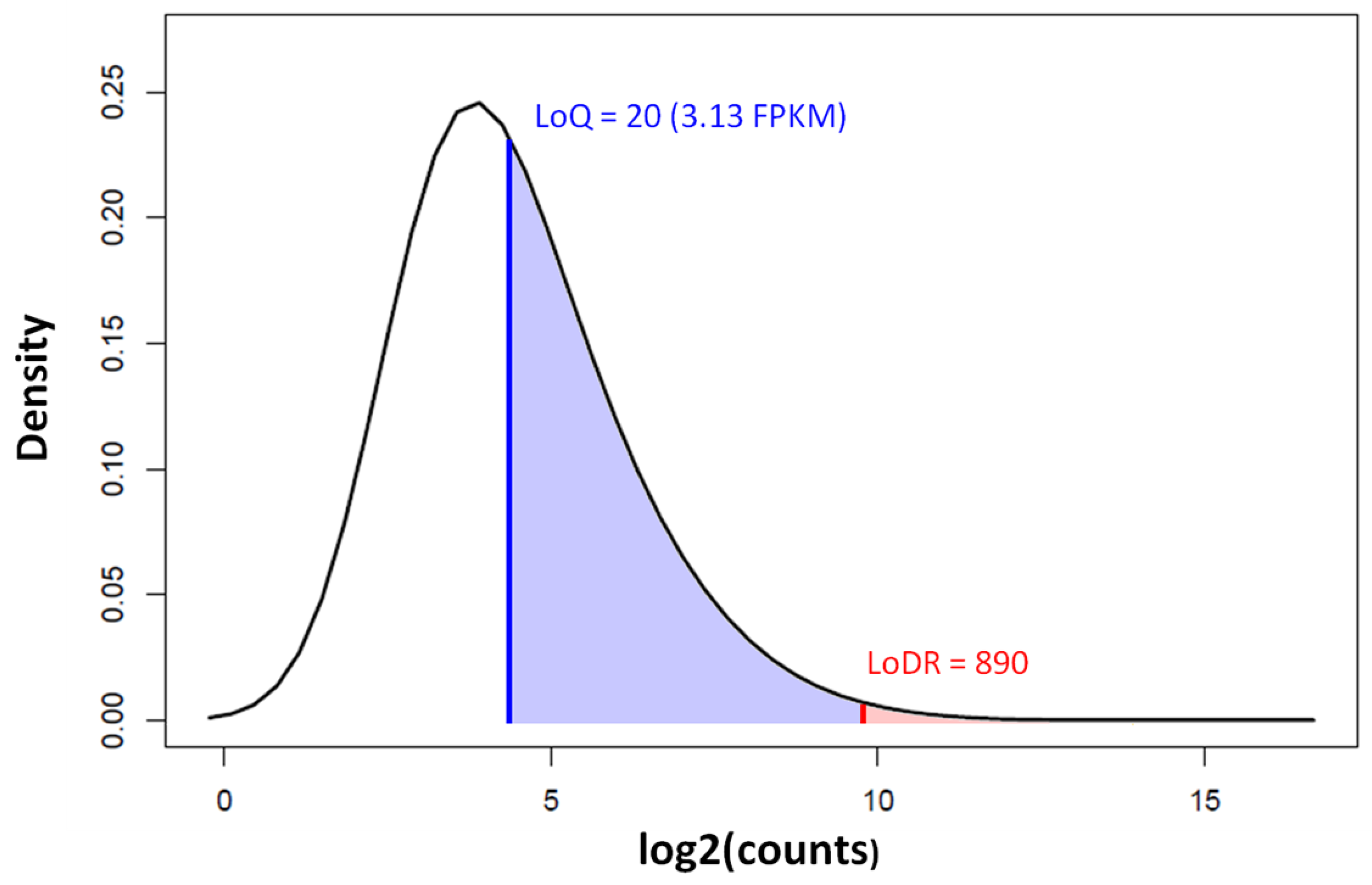

| Human | Mouse | Rat | |
|---|---|---|---|
| CircRNA microarray | Human CircRNA microarray V2 | Mouse CircRNA microarray V2 | Rat CircRNA microarray V1 |
| GEO platform ID | GPL21825 | GPL21826 | GPL21828 |
| CircRNA probes | 13,617 | 14,236 | 14,145 |
| Probe length | 60 nt | ||
| Probe sequence | Targeting the circular junctions | ||
| Labeling method | CircRNA enrichment by RNase R treatment; Random priming for reverse transcription; Linear cRNA amplification by T7 polymerase transcription in vitro; Fluorescent labeling by C3-UTP incorporation. | ||
| Array Format | 8 × 15K | 8 × 15K | 8 × 15K |
| circRNA sources | |||
| Salzman’s circRNAs [2] | 8529 | ||
| Memczak’s circRNAs [3] | 1601 | 1750 | |
| Zhang’s circRNAs [7] | 93 | ||
| Zhang’s circRNAs [6] | 4980 | ||
| Jeck’s circRNAs [4] | 3769 | ||
| Guo’s circRNAs [5] | 5536 | 570 | |
| You’s circRNAs [8] | 13,300 | 12,298 | |
| Mouse orthologs | 1668 | ||
| Human orthologs | 179 | ||
| QC flag | P (Present) | A (Absent) | M (Marginal) |
|---|---|---|---|
| Feature is not positive and significant | X | ||
| Feature is not uniform | X | ||
| Feature is not above background | X | ||
| Feature is saturated | X | ||
| Feature is population outlier | X | ||
| Background is not uniform | X | ||
| Background is population outlier | X |
| circRNA | ProbeID | p-Value | FDR | FC (Abs) | Regulation |
|---|---|---|---|---|---|
| hsa_circRNA_104264 | ASCRP3004838 | 0.00002735 | 0.001493 | 6.955 | up |
| hsa_circRNA_001593 | ASCRP3007121 | 0.00009951 | 0.005795 | 3.627 | down |
| hsa_circRNA_007223 | ASCRP3010883 | 0.00006019 | 0.003864 | 1.774 | down |
| Biofluid | Liquid Volume | Typical Total RNA Yield * | Starting Vol. for Exosome Isolation |
|---|---|---|---|
| Whole blood | 0.5 mL or 2 million blood cells | tens of micrograms | |
| Plasma | 1–2 mL | 300–1500 ng/mL | 2 mL |
| Serum | 1–2 mL | 300–1500 ng/mL | 2 mL |
| Saliva | 200 μL | 0.9–7 µg | |
| Amniotic fluid | 1–2 mL | 4 µg/mL | |
| Cell culture medium | 50 mL | 20 ng/mL | 50 mL |
| Urine | 50 mL |
| Sample Type | Title | Journal | Pubmed |
|---|---|---|---|
| plasma | Circular RNA in blood corpuscles combined with plasma protein factor for early prediction of pre-eclampsia. | BJOG (2016) | 26846540 |
| plasma | Microarray profiling and functional analysis reveal the regulatory role of differentially expressed plasma circular RNAs in Hashimoto’s thyroiditis. | Immunol Res (2022) | 35064448 |
| plasma | Circular RNA expression profiles in the plasma of patients with infantile hemangioma determined using microarray analysis. | Exp Ther Med (2021) | 33968165 |
| plasma | Plasma circular RNA panel acts as a novel diagnostic biomarker for colorectal cancer detection. | Am J Transl Res (2020) | 33312376 |
| plasma | Identification of plasma hsa_circ_0008673 expression as a potential biomarker and tumor regulator of breast cancer. | J Clin Lab Anal (2020) | 32808350 |
| plasma | Plasma hsa_circ_0027089 is a diagnostic biomarker for hepatitis B virus-related hepatocellular carcinoma. | Carcinogenesis (2020) | 31535687 |
| plasma | Selective downregulation of distinct circRNAs in the tissues and plasma of patients with primary hepatic carcinoma. | Oncol Lett (2019) | 31612035 |
| plasma | Circulating plasma circular RNAs as novel diagnostic biomarkers for congenital heart disease in children. | J Clin Lab Anal (2019) | 31429492 |
| plasma | Using plasma circRNA_002453 as a novel biomarker in the diagnosis of lupus nephritis. | Mol Immunol (2018) | 30172209 |
| plasma | Dysregulated circRNAs in plasma from active tuberculosis patients. | J Cell Mol Med (2018) | 29961269 |
| serum | Plasma circular RNA profiling of patients with gastric cancer and their droplet digital RT-PCR detection. | J Mol Med (2018) | 29098316 |
| serum | Effects of renal denervation on the expression profile of circular RNA in the serum of patients with resistant hypertension. | Hellenic J Cardiol (2022) | 34147676 |
| serum | Correlation between serum circRNA and thyroid micropapillary carcinoma with cervical lymph node metastasis. | Medicine (2020) | 33217846 |
| exosomes | Exosomal circCARM1 from spheroids reprograms cell metabolism by regulating PFKFB2 in breast cancer. | Oncogene (2022) | 35027669 |
| exosomes | Serum exosomal hsa_circ_0069313 has a potential to diagnose more aggressive non-small cell lung cancer. | Clin Biochem (2022) | 35077682 |
| exosomes | Exosomal hsa_circRNA_104484 and hsa_circRNA_104670 may serve as potential novel biomarkers and therapeutic targets for sepsis. | Sci Rep (2021) | 34238972 |
| exosomes | Hypoxic exosomal HIF-1α-stabilizing circZNF91 promotes chemoresistance of normoxic pancreatic cancer cells via enhancing glycolysis. | Oncogene (2021) | 34294845 |
| exosomes | Tumor-derived exosomal circRNA051239 promotes proliferation and migration of epithelial ovarian cancer. | Am J Transl Res (2021) | 33841644 |
| exosomes | Identification of low-dose radiation-induced exosomal circ-METRN and miR-4709-3p/GRB14/PDGFRα pathway as a key regulatory mechanism in Glioblastoma progression and radioresistance: Functional validation and clinical theranostic significance. | Int J Biol Sci (2021) | 33867829 |
| exosomes | Exosomal circEhmt1 Released from Hypoxia-Pretreated Pericytes Regulates High Glucose-Induced Microvascular Dysfunction via the NFIA/NLRP3 Pathway. | Oxid Med Cell Longev (2021) | 33815662 |
| exosomes | Exosomal circular RNA_400068 promotes the development of renal cell carcinoma via the miR-210-5p/SOCS1 axis. | Mol Med Rep (2020) | 33173957 |
| exosomes | Microarray profiling and functional analysis of differentially expressed plasma exosomal circular RNAs in Graves’ disease. | Biol Res (2020) | 32727578 |
| exosomes | CircRNA-0077930 from hyperglycaemia-stimulated vascular endothelial cell exosomes regulates senescence in vascular smooth muscle cells. | Cell Biochem Funct (2020) | 32307741 |
| exosomes | Exosome circ_0044516 promotes prostate cancer cell proliferation and metastasis as a potential biomarker. | J Cell Biochem (2020) | 31625175 |
| exosomes | Abnormal expression of circRNA_089763 in the plasma exosomes of patients with post-operative cognitive dysfunction after coronary artery bypass grafting. | Mol Med Rep (2019) | 31524256 |
| exosomes | Tumor-released exosomal circular RNA PDE8A promotes invasive growth via the miR-338/MACC1/MET pathway in pancreatic cancer. | Cancer Lett (2018) | 29709702 |
| exosomes | Circular RNA IARS (circ-IARS) secreted by pancreatic cancer cells and located within exosomes regulates endothelial monolayer permeability to promote tumor metastasis. | J Exp Clin Cancer Res (2018) | 30064461 |
| circRNA | microRNA | Effect mRNA | Indications | Pubmed |
|---|---|---|---|---|
| circACTN4 | miR-424-5p | YAP1 | Cancer | 34509526 |
| Hsa_circ_0003258 | miR-653-5p | YAP1 | Cancer | 34986849 |
| circDLG1 | miR-141-3p | CXCL12 | Cancer | 34911533 |
| circRNF220 | miR-30a | MYSM1, IER2 | Leukemia | 34702297 |
| circMEMO1 | miR-106b-5p | TET | Cancer | 33985545 |
| circHIPK3 | miR-29b | Rac1, Cdc42, cyclin B1 | Repair of intestinal epithelium | 34116030 |
| circEXOC7 | miR-149-3p | CSF1 | Renal cell carcinoma | 33783995 |
| circNFXL1_009 | miR-29b | KCNB1 | Pulmonary hypertension | 33614247 |
| circ-HMGA2 | miR-1236-3p | ZEB1 | Lung adenocarcinoma | 33762580 |
| circ-METRN | miR-4709-3p | GRB14 | Glioblastoma | 33867829 |
| circANAPC2 | miR-874-3p | SMAD3 | Endochondral ossification | 33713570 |
| circ-ANXA7 | miR-331 | LAD1 | Lung adenocarcinoma | 33536022 |
| circRIMS2 | miR-186 | BDNF | Neuronal apoptosis | 33413076 |
| circ_0077755 | miR-182 | Breast cancer | 33514777 | |
| circ_0071036 | miR-489 | Pancreatic cancer | 33507122 | |
| circMTO1 | miR-630 | KLF6 | Osteosarcoma | 33506896 |
| circPTCH1 | miR-485-5p | MMP14 | Renal cell carcinoma | 32929380 |
| circPRRC2A | miR-514a, 6776 | TRPM3 | Renal cell carcinoma | 32292503 |
| circCTNNA1 | miR-149-5p | FOXM1 | Colorectal cancer | 32699205 |
| circNRIP1 | miR-629-3p | PTP4A1/ERK1 | Cervical cancer | 32457332 |
| circErbB4 | miR-29a-5p | VSMC migration | 32514012 | |
| circ5615 | miR-149-5p | TNKS | Colorectal cancer | 32393760 |
| Tissues or Cells | circRNA Raw Counts | circRNA Study |
|---|---|---|
| frontal cortex | 3 | [50] |
| parietal lobe | 7 | |
| diencephalon | 2 | |
| K562 | 3 | [2] |
| Gm12878 | 13 | |
| Sknshra | 1 | |
| H1hesc | 3 | |
| Helas3 | 2 | |
| Huvec | 0 | |
| A549 | 3 | |
| Ag04450 | 1 |
| circRNA Microarray | circRNA-Seq | |
|---|---|---|
| Technology platform | Arraystar Human CircRNA Microarray V2 | Illumina NovaSeq 6000 (40 mil paired-end read coverage, 150-base read length) |
| GEO Accession | GSE159669 | GSE205241 |
| Differential analysis method | limma R-package (Version 3.54.1) [21] | edgeR R-package (Version 3.40.2) [53,54,55] |
| Stringency cutoffs | |FC| ≥ 2 p ≤ 0.05 Intensity ≥ 7.2 * | |FC| ≥ 2 p ≤ 0.05 Raw counts ≥ 890 (LoDR) ** |
| Differentially expressed circRNAs | 150 | 4 |
| circRNA Microarray * | circRNA-Seq |
|---|---|
| High sensitivity for finding differentially expressed circRNAs. | The numbers of circRNAs above the LoDR are small for quantitative detection of differentially expressed circRNAs.Deep sequencing coverage to get higher circRNA counts incurs high costs.Artifacts and false positives in circRNA-seq library prep. |
| Unambiguous, accurate, and reliable circular junction-specific array probes. | Less reliable/accurate/established computational methods for circular RNAs. |
| Dedicated circRNA annotation and analysis to gain insights into the circRNA biology via the specialized circRNA microarray service. | Publicly available circRNA annotations are basic. |
| Good for differentially expressed circRNA analysis for humans, mice, and rat. Not available for species without established cataloged circRNAs. | Good for de novo discovery of circRNAs (e.g., in species other than humans, mice and rats). |
Disclaimer/Publisher’s Note: The statements, opinions and data contained in all publications are solely those of the individual author(s) and contributor(s) and not of MDPI and/or the editor(s). MDPI and/or the editor(s) disclaim responsibility for any injury to people or property resulting from any ideas, methods, instructions or products referred to in the content. |
© 2023 by the authors. Licensee MDPI, Basel, Switzerland. This article is an open access article distributed under the terms and conditions of the Creative Commons Attribution (CC BY) license (https://creativecommons.org/licenses/by/4.0/).
Share and Cite
Shi, Y.; Shang, J. Circular RNA Expression Profiling by Microarray—A Technical and Practical Perspective. Biomolecules 2023, 13, 679. https://doi.org/10.3390/biom13040679
Shi Y, Shang J. Circular RNA Expression Profiling by Microarray—A Technical and Practical Perspective. Biomolecules. 2023; 13(4):679. https://doi.org/10.3390/biom13040679
Chicago/Turabian StyleShi, Yanggu, and Jindong Shang. 2023. "Circular RNA Expression Profiling by Microarray—A Technical and Practical Perspective" Biomolecules 13, no. 4: 679. https://doi.org/10.3390/biom13040679
APA StyleShi, Y., & Shang, J. (2023). Circular RNA Expression Profiling by Microarray—A Technical and Practical Perspective. Biomolecules, 13(4), 679. https://doi.org/10.3390/biom13040679





